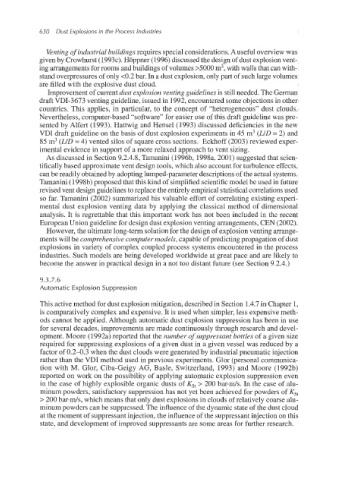Page 663 - Dust Explosions in the Process Industries
P. 663
630 Dust Explosions in the Process Industries
Ventingof industrialbuildingsrequires special considerations.A useful overview was
given by Crowhurst (1993~).Hoppner (1996) discussedthe design of dust explosion vent-
ing arrangements for rooms and buildings of volumes >5000 m3,with walls that can with-
stand overpressuresof only <0.2 bar. In a dust explosion,only part of such large volumes
are filled with the explosive dust cloud.
Improvement of current dust explosion venting guidelines is still needed. The German
draft VDI-3673 venting guideline,issued in 1992,encounteredsome objectionsin other
countries. This applies, in particular, to the concept of “heterogene~us’~dust clouds.
Nevertheless, computer-based “software” for easier use of this draft guideline was pre-
sented by Alfert (1993). Hattwig and Hensel (1993) discussed deficiencies in the new
VDI draft guideline on the basis of dust explosion experiments in 45 m3 (L/D= 2) and
85 m3(L/D= 4) vented silos of square cross sections. Eckhoff (2003) reviewed exper-
imental evidence in support of a more relaxed approach to vent sizing.
As discussed in Section 9.2.4.8, Tamanini (1996b, 1998a,2001) suggested that scien-
tifically based approximate vent design tools, which also account for turbulence effects,
can be readily obtained by adopting lumped-parameterdescriptionsof the actual systems.
Tamanini (1998b)proposed that this kind of simplified scientific model be used in future
revised vent design guidelinesto replace the entirely empirical statisticalcorrelationsused
so far. Tamanini (2002) summarized his valuable effort of correlating existing experi-
mental dust explosion venting data by applying the classical method of dimensional
analysis. It is regrettable that this important work has not been included in the recent
European Union guidelinefor design dust explosionventing arrangements, CEN (2002).
However,the ultimate long-term solution for the design of explosionventing arrange-
ments will be comprehensivecomputer models, capable of predicting propagation of dust
explosions in variety of complex coupled process systems encountered in the process
industries. Such models are being developed worldwide at great pace and are likely to
become the answer in practical design in a not too distant future (see Section 9.2.4.)
9.3.7.6
Automatic Explosion Suppression
This active method for dust explosion mitigation, described in Section 1.4.7in Chapter 1,
is comparatively complex and expensive. It is used when simpler, less expensive meth-
ods cannot be applied. Although automatic dust explosion suppression has been in use
for several decades, improvements are made continuously through research and devel-
opment. Moore (1992a) reported that the number of suppressant bottles of a given size
required for suppressing explosions of a given dust in a given vessel was reduced by a
factor of 0.2-0.3 when the dust clouds were generated by industrialpneumatic injection
rather than the VDI method used in previous experiments. Glor (personal communica-
tion with M. Glor, Ciba-Geigy AG, Basle, Switzerland, 1993) and Moore (1992b)
reported on work on the possibility of applying automatic explosion suppression even
in the case of highly explosible organic dusts of Ks, > 200 bwds. In the case of alu-
minum powders, satisfactory suppression has not yet been achieved for powders of Ks,
> 200 bar.m/s, which means that only dust explosions in clouds of relatively coarse alu-
minum powders can be suppressed.The influence of the dynamic state of the dust cloud
at the moment of suppressantinjection, the influence of the suppressantinjection on this
state, and development of improved suppressants are some areas for further research.

